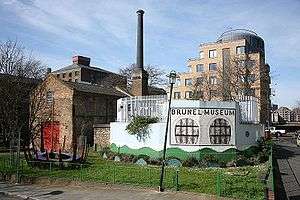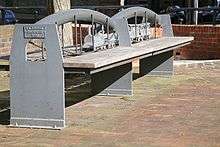Brunel Museum
The Brunel Museum is a museum in the Brunel Engine House, Rotherhithe, London Borough of Southwark. The Engine House was designed by Sir Marc Isambard Brunel to be part of the infrastructure of the Thames Tunnel.

Brunel Engine House

The Engine House was designed by Sir Marc Isambard Brunel to be part of the infrastructure of the Thames Tunnel. It held steam-powered pumps used to extract water from the tunnel.
Since 1961 the building has been used as a museum displaying information on the construction of the tunnel and the other projects by Marc and Isambard Kingdom Brunel. Structural decay was prevented in 1975 by a charitable trust named "Brunel Exhibition Rotherhithe".
In 2006 the museum changed its name from Brunel Engine House to Brunel Museum and has expanded its exhibition to include a new mural on the shaft showing the tunnel shield, and other works by the Brunels, such as models of famous Brunel bridges incorporated into bench seating.
In 2018, the museum raised more than £200,000, including a major grant from the National Heritage Memorial Fund, to buy the album including a collection of drawings of the Thames Tunnel, prepared or overseen by Marc Isambard Brunel (1769 –1849).[1]
Open House Weekend
The Brunel Museum takes part in the Open House Weekend event every year and, until the East London Line's temporary closure in 2007, took parties of people through the tunnel on the Underground trains as part of a guided tour of the tunnel.
The future
The museum underwent major building works in 2007. This entailed relocating the Rennie flat V steam engine to the Chatham Historic Dockyard to create a larger exhibition space, a cafe and improved toilet facilities. With the closure of the East London Line in December 2007 for extensive upgrading the museum hoped that the access shaft into the tunnel (originally built to be the grand entrance hall to the tunnel) could be capped with a concrete shelf at the bottom, above the level of the trains.[2] This shelf was completed in early 2010, with the inauguration taking place in late January. The access shaft took in its first groups from the general public on 14 February 2010 (Valentine's Day) when it was opened as the 'Tunnel of Love' for short historical presentations detailing the history of the tunnel and of some interesting historical notes from the private life and diary of Brunel's son, Isambard.
The museum now plans to continue the fit-out of the shaft, which will house exhibition and performance space.
References
Notes
- "Thames Tunnel archive comes home to Brunel Museum". The Guardian. 18 February 2018.
- Transport for London helps Brunel Museum | Transport for London
Bibliography
- The Brunels' Tunnel, Michael Palin (Foreword), Andrew Mathewson (Author), Derek Laval (Author), Julia Elton (Author), Eric Kentley (Author, Editor), The Brunel Museum (24 May 2006), ISBN 0-9504361-2-7